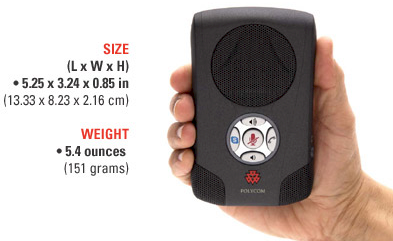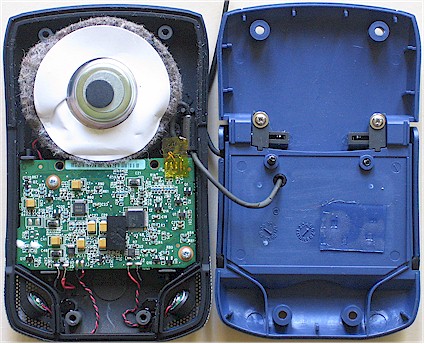Introduction
| At a Glance | |
|---|---|
| Product | Polycom Communicator (C100S) |
| Summary | Easy to use high fidelity Skype speakerphone |
| Pros | • Easy to set up and use • Excellent voice quality |
| Cons | • Call initiation can be confusing • Attached USB cable not user-replaceable |
At the recent VON show, I dropped by Polycom’s booth to check out its “HD Voice” wideband audio technology demo. I used many a POTS Polycom speakerphone in my former corporate life and always have been impressed with the products. They are uniquely styled, solidly built and a big improvement over the old Western Electric “squawk boxes”. So when I spied the Communicator, I asked for a short demo and then for a review unit, which Polycom quickly sent.

The Communicator is a high-fidelity full-duplex Skype speakerphone that is worthy of the Polycom logo that it bears. The heavy plastic casing looks and feels more like metal, probably due to the judicious use of real metal grilles for the speaker and stereo microphones. Its size and weight will remind you of a PDA that needs a few weeks on the South Beach diet, but it’s definitely built for on-the-go as well as stay-at-home/office use.
The Communicator’s portability is enhanced by the nice quality zippered case that comes with it, as well as its integrated USB cable and elegantly-designed storage method (Figure 1).

Figure 1: Communicator rear view showing USB cable storage
All you need to do is flip open the back cover, which doubles as a stand to elevate the device into proper working position, unwind the thin one meter USB cable and plug in. You then run the Driver / Software Install CD, which doesn’t actually contain any software, but just a nice GUI that directs you to the proper places on the Polycom and Skype websites to download up-to-date versions of the installer(s) you need.

Figure 2: Communicator physical info
Note that you even get a 3.5 mm stereo headphone jack in case you prefer that way of listening.
Design Info and In Use
Opening up the Communicator shows the experience that Polycom brings to the high-quality speakerphone table (Figure 3). The speaker is surrounded by a ring of sound-dampening felt-like material and the two microphones are suspended in soft rubber-like plastic holders that are part of the seal that runs around the case perimeter.
Figure 3: Communicator internal view (click image to enlarge)
The larger IC to the right of the photo is a TI TAS1020B Stereo USB Audio Interface. According to its data manual, the chip is designed specifically for applications that require isochronous data streaming. The TAS1020B uses a standard 8052 microcontroller unit (MCU) core with on-chip memory including 8K bytes of program memory ROM with boot loader and a 6,016-byte RAM that is loaded from the ROM. I didn’t remove the board, so it’s possible that there are more components on the other side.
You can see that the USB cable is soldered to the board, which means that once it breaks or develops a dreaded intermittent connection, and the 12 month warranty period has expired, the Communicator is probably toast. I asked Polycom about this and received the following reply:
… within warranty if there is an issue we would simply replace the unit, and for out of warranty there is not a repair plan available because it is such as low-cost item. Out of warranty, we will work with customers who have issues to determine replacement details.
Using the Communicator is very straightforward. The user interface consists of five buttons and a ring around them that can be lit red or green (Figure 4). The purpose of each button is clear from its icon and the indicator ring blinks while placing or receiving a call and glows a steady green while a call is in progress. Pressing the mute button will cause the ring to turn a steady red and it will blink red if the calling party puts the call on hold. Note that there is no way for you to put a call on hold using the Communicator’s controls. For that, you’ll need to futz with the Skype GUI itself.

Figure 4: User interface buttons and lighted ring
Call quality is excellent, with no feedback or echo and the full fidelity you get from using a headset/mic combo. You can listen to this short clip of my call to the Skype Test ‘bot (MP3, 200 kB) or use the Interactive Demo on Polycom’s site to judge for yourself. In my test clip, you’ll hear my voice twice – first while being recorded, then while played back by the Skype ‘bot. (I used HotRecorder to record the test and its bundled AudioConverter app to convert the file from Hotrecorder’s proprietary format to MP3.)
Closing Thoughts
As you might guess, I give the Communicator a hearty thumbs up. Yes, at around $100 on-line street, it will set you back three times the cost of Actiontec’s VoSKY Chatterbox. But what you get in call quality is definitely worth it, especially if you use Skype for business calling, which I know many people do.
But, as good as the product is, there are a few improvements I’d like to suggest. The main thing I’d like to see is the ability to use the volume up/down buttons to navigate through the Skype contacts list before placing a call. This would allow you to make a call without having to go over to the Skype GUI.
Since you can launch Skype and open and close the Skype window without touching your computer’s keyboard, this would a logical improvement. I have to confess to bothering a few of my Skype contacts while testing out the Communicator by not first selecting the person that I really intended to call before hitting the Communicator call button.
The other request is a longer USB cable, or to throw in a USB cable extender. A meter / 3 feet is ok for use with a notebook. But even with my compact desktop machine mounted on a desk-height shelf and having a front panel USB port, I wanted to move the Communicator further away to minimize pickup of its fan noise, but couldn’t.
But don’t let these minor complaints confuse you. The Polycom Communicator is the Skype speakerphone that the other guys want to be when they grow up!

